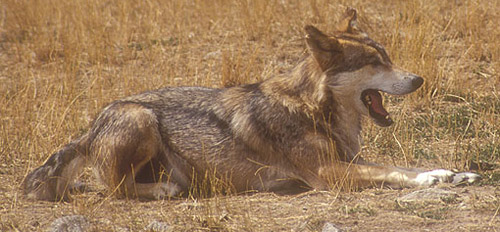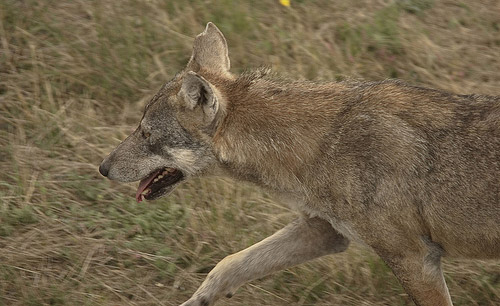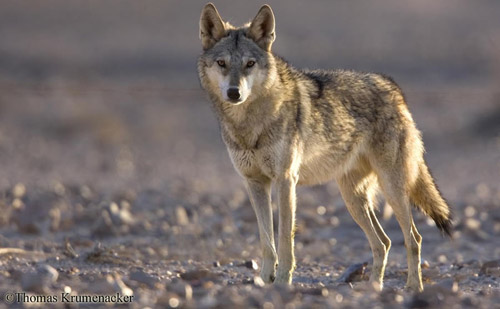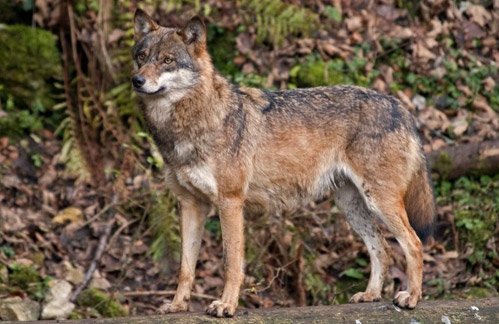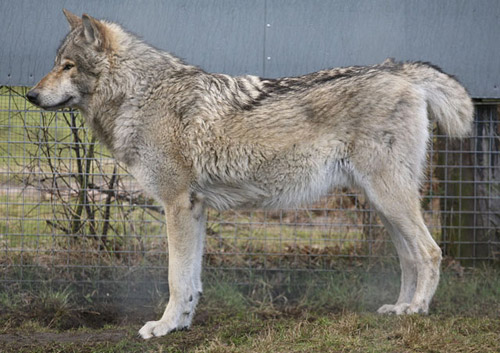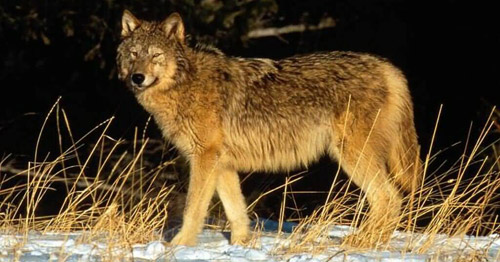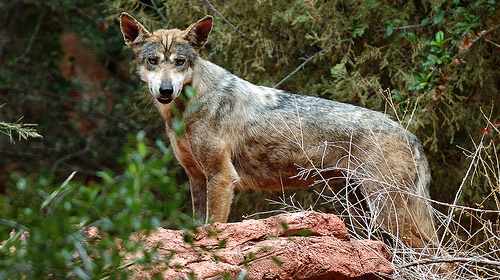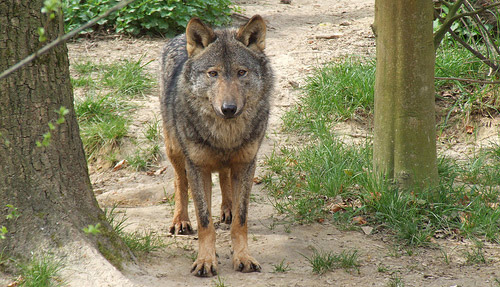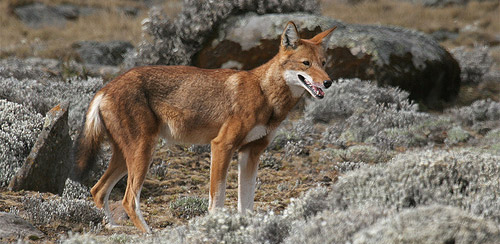
WOLF DIET
Wolves eat ungulates, or large hoofed mammals, like elk, deer, moose and caribou. Wolves are also known to eat beaver, rabbits and other small prey. Wolves are also scavengers and often eat animals that have died due to other causes like starvation and disease. They have been know to survive on voles and mice if need be.

WOLF POPULATION
There are an estimated 7,000 to 11,200 wolves in Alaska and more than 5,000 in the lower 48 states. Around the world there are an estimated 200,000 in 57 countries, compared to up to 2 million in earlier times.

WOLF BEHAVIOR
Wolves live, travel and hunt in packs of 4-7 animals on average. Packs include the mother and father wolves, called the alphas, their pups and several other subordinate or young animals. The alpha female and male are the pack leaders that track and hunt prey, choose den sites and establish the pack's territory. Wolves develop close relationships and strong social bonds. They often demonstrate deep affection for their family and may even sacrifice themselves to protect the family unit.
Threats
The most common cause of death for wolves is conflict with people over livestock losses. While wolf predation on livestock is fairly uncommon, wolves that do prey on them are often killed to protect the livestock. Defenders is working with livestock owners to develop non-lethal methods to reduce the chances of a wolf attacking livestock. These methods include fencing livestock, lighting, alarm systems and removing dead or dying livestock that may attract carnivores like wolves.
Defenders' Proactive Wolf Efforts
Another serious threat is human encroachment into wolf territory, which leads to habitat loss for wolves and their prey species.
Overall, the greatest threat to wolves is people's fear and misunderstanding about the species. Many fairy tales and myths tend to misrepresent wolves as villainous, dangerous creatures.
The Grey wolf once inhabited most of North America, but was nearly exterminated over the last century. A top predator species, wolves are critical to sustaining the proper functioning of ecosystems by helping keep prey populations in check.
Under protection of the Endangered Species Act, wolves are now rebounding in parts of their historic range. In the Northern Rockies region, reintroduction of wolves to Idaho, Montana and Wyoming began in the mid-1990's, and has been a success. Wolves can now be readily viewed not only in the Yellowstone region, but the Sawtooth Valley and other parts of Idaho and Montana.
Yet animosity to wolves still runs deep in some circles, including among many public lands ranchers who fear -- unjustifiably -- wolf predations of their liestock. Because of the ranching industry's political clout, state and federal wildlife managers will kill entire wolf packs when even a single sheep or calf may have been killed by wolves -- even though the ranchers may have turned out their livestock right in the midst of a wolf den.
Removing wolves from Endangered Species Act protection in the northern Rockies threatens to undo the gains made in recent years. Eliminating or limiting domestic livestock grazing on public lands in wolf areas is one key step to reducing conflicts and ensuring future survival of wolf populations in the West.

Wolf relationships with the pack
Wolves are probably the most social of the animals, and have the most complex relationships in their packs of any other creature. In the pack order the leader is submissive to no other wolf, and his mate only to him. Next in the hierarchy is the Beta couple. They are submissive only to the Alpha pair. This continues on to the lowest member of the pack, submissive to all, dominant over none. As long as no wolf challenges those who are over him or her, all goes smoothly. However, a wolf that wants to rise in the pack will have to test another who who is dominant. The challenge and test is extremely ritualized. First, the dominant wolf stares into the challenger's eyes, a low growl also accompanies this display. If the challenging wolf returns the stare, the dominant wolf will show his teeth and snarl. If this too is echoed, the dominant wolf will bump the challenger with his shoulder, or place his paws on the challenger's back. The other wolf's reaction will decide whether the challenge is in earnest. If so, the challenger will knock the other wolf back, or sidestep so he drops back to the ground. The staring and teeth-baring begin again. Now the challenging wolf bumps,or puts his paws on the the dominant wolf's back. If the dominant wolf bumps or sidesteps him, he will raise tail and hackels. If this display is reciprocated, they will fight. They usually will not cause serious injury, and almost never death. The winner is decided when one of the wolves gets in a position where it could do serious harm to the other. The loser yelps and falls to his back, displaying his vulnerable underside, and tucking in his tail. The winner then stands tall, growling, then steps back and allows the loser to rise testing him with eye contact and bared teeth. When the loser falls down again, or turns away, the victor allows him to stand. After the battle the pack functions smoothly again, no grudges are held. Many relatives of the wolf, such as the Dingo or Cape Hunting Dog use this system in a similar, but lesser way.
.

The
Arctic wolf
(Canis Lupus Arctos) is the purest of all the wolf breeds, as it is in such an isolated area in the Arctic Circle. They can be easily recognized, as they are the only Grey wolf sub-species with a thick, near-white coat. Their coat protects them from predators through its camouflage, and the warmth that they need to survive in the Arctic temperatures. They are about 3-5 ft long, and about 25-31 inches high to their shoulders. The males can weigh up to 175 lbs, but the females are lighter than the males. This extra body mass is for the warmth. Their ears are smaller and rounder than the other sub-species of Gray wolf, and their muzzle and legs are slightly shorter. These differences are the adaptation to the cold, as they decrease exposure to the cold, as they have to endure temperatures that reach –57’C (-70’F).er. Arctic wolves reach sexual maturity at 3 years in the males, and 2 years for the females. The gestation period is about 53-61 days, and they usually have about 1-6 pups. The pups are born slightly later than the wolves further south, usually around the end of May. Like the other types of wolf, the Arctic Wolf has very tight family bonds, and other younger members of the pack will often look after the pups while the mother is away hunting. The Arctic wolves have been known to have up to 30 members a pack, but usually only have about 7 to 10. They have a vast territory, as their prey is small and less frequent in the finding.They live throughout the Arctic landmass, except for the on the permanent ice sheets on the sea, and can have more than 1000 square miles (2600 sq km.) of territory. Their main food sources are arctic hares, musk ox, caribou, lemmings and some birds. As the food is so scarce in the Arctic, there is rarely anything left of the carcass, such as with the arctic hare, as they will eat the skin, fur and bones. The Arctic Wolf has a life span of about 7 years on average. Unlike the other types of wolves that have been persecuted by humans the Arctic wolf is thought to still have 95% of its territory in the Arctic. They only have to worry about fur trappers, oil drilling and hikers in the Arctic. Due to the bad weather conditions in the Arctic, we can only know what happens to the Arctic wolf in the summer, as it is both too dark and too cold to see anything in the winter.
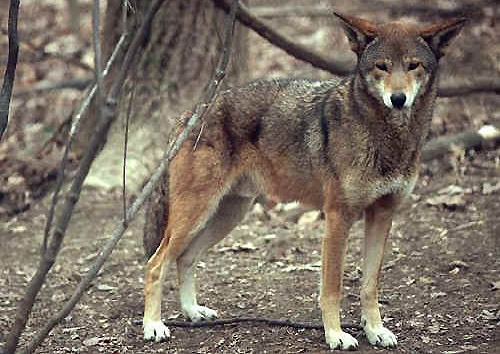
The
Red wolf
(Canis Rufus) is the smallest of all the wolves. They usually weigh 50-70 pounds and stand to about 51-81 cm (20-32 inches) tall to the shoulder. They usually have a reddish-brown coat, and are smaller than the gray wolf, have smaller packs than the gray, which are usually consist of an adult couple and their offspring. They mate every year and have an average of 2-5 pups. Both the male and the female look after the offspring. The pups stay with this pack and it’s mother until it is about 18 months old when they can fend for themselves. They will then travel away to set up a pack of their own.The Red Wolf can be found as far north as Pennsylvania and as far west as Texas. They like temperate deciduous forest areas, and need between 10 and 100 square miles of habitat to live and hunt in. They like to eat white tailed deer and raccoons, but can eat any small animals if pushed. In recent times there has been a loss of the Red Wolf’s habitat, due to the expansion of agriculture, logging and human settlement. With the combination of the hunting of wolves that takes place (they preyed on cattle), coupled with the fact that the red wolf has been mating with coyotes, and coyotes expanding into their territory, the red wolf numbers have dwindled. Also there happened diseases such as heartworm, which preyed on the wolves.In 1967 the Red Wolf was made an endangered species. In 1980 the Red Wolf was declared extinct in the wild. Currently there are only 300 Red Wolves in the world, and only 75-80 of them surviving in the wild.

There
are fourteen recognised sub-species of the Grey Wolf. The gray wolf (Canis
Lupus) is the largest and most common type of wolf, 2-2.5 ft tall and 4-5 ft
long. The males are about 100-175 lbs and the females are slightly lighter.
Unlike common perception, they are not as large as they seem because of their
thick fur; in fact they are about the size of a good-sized Alsatian.Although
they are known as the Grey Wolf, their color can vary from pure black to pure
white, and through gray and brown, or a combination. Like most 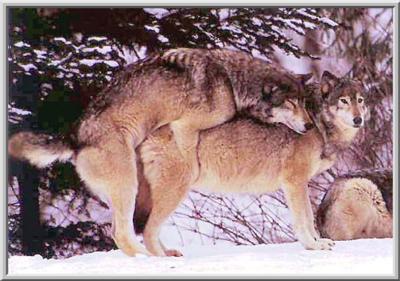 wolves, they
usually mate for life, and breed in late winter and conceive about two months
later. The pups are born blind and are reared in a den and weaned in about the
5th week. When they are 3-5 months old, they are old enough to run with the
pack. They will be adult size by winter. Grey wolves are sexually mature at
the age of about 22-24 months.They were formally found throughout the
northern hemisphere in Alaska, Canada, the region around the Great Lakes. They
were hunted to extinction in all other areas of the country. The wolf population
was lowest in Eurasia in 1930’s and 60’s, and lowest in North America in the
1950’s. In 1995 there was a reintroduction of the Gray Wolf into the wilderness
areas like the Rocky Mountains. There were also 30 Gray Wolves reintroduced
into Yellowstone National Park in Wyoming, Minnesota, and are thriving. There
are also some in the Isle Royal National Park, Michigan. There are now 2,500
Gray wolves in the lower 48 states of America, and 10,000 in Alaska to date.The Grey Wolf is very important to the food
chain, as, as it is at top it controls the populations of the caribou, deer
and moose. The wolves take the sick and weak animals such as the older ones
(they wouldn’t bother with a healthy moose that stands its ground), making sure
that the strongest of the herds survive, and so making the herd stronger through
this type of selective breeding. A good example of when this was not the case,
was when in Yellowstone National Park. There were no wolves there, and the populations
of these herds multiplied extensively, ended up over grazing the land, creating
a food shortage, and many of these animals died from this. The wolves have been
reintroduced here and the balance is even again.There are also as many as 30 sub-species
(only 14 of them are recognized) of the Gray Wolf, such as the Mexican wolf,
which is indigenous to the Southwestern Deserts of America.
wolves, they
usually mate for life, and breed in late winter and conceive about two months
later. The pups are born blind and are reared in a den and weaned in about the
5th week. When they are 3-5 months old, they are old enough to run with the
pack. They will be adult size by winter. Grey wolves are sexually mature at
the age of about 22-24 months.They were formally found throughout the
northern hemisphere in Alaska, Canada, the region around the Great Lakes. They
were hunted to extinction in all other areas of the country. The wolf population
was lowest in Eurasia in 1930’s and 60’s, and lowest in North America in the
1950’s. In 1995 there was a reintroduction of the Gray Wolf into the wilderness
areas like the Rocky Mountains. There were also 30 Gray Wolves reintroduced
into Yellowstone National Park in Wyoming, Minnesota, and are thriving. There
are also some in the Isle Royal National Park, Michigan. There are now 2,500
Gray wolves in the lower 48 states of America, and 10,000 in Alaska to date.The Grey Wolf is very important to the food
chain, as, as it is at top it controls the populations of the caribou, deer
and moose. The wolves take the sick and weak animals such as the older ones
(they wouldn’t bother with a healthy moose that stands its ground), making sure
that the strongest of the herds survive, and so making the herd stronger through
this type of selective breeding. A good example of when this was not the case,
was when in Yellowstone National Park. There were no wolves there, and the populations
of these herds multiplied extensively, ended up over grazing the land, creating
a food shortage, and many of these animals died from this. The wolves have been
reintroduced here and the balance is even again.There are also as many as 30 sub-species
(only 14 of them are recognized) of the Gray Wolf, such as the Mexican wolf,
which is indigenous to the Southwestern Deserts of America.
Range and Habitat: The Northwestern wolf, more commonly known as the Rocky Mountain wolf inhabits parts of the western United States, western Canada, and Alaska, including Unimak Island of the Aleutians, and is the sub-species that was reintroduced into Yellowstone National Park (YNP) and central Idaho in 1995-6.Territory size in Alaska averages 600 square miles, while wolf packs in YNP average 9.2 wolves with an average territory of 348 square miles.
Behavior and Communication: The wolf pack is one of nature's most sophisticated social orders, as well as one of the most intensively studied. A wolf pack is usually a family group of five to eight animals, usually consisting of a pair of breeding adults and their young of 1 or 2 years old. The breeding pair is likely to be the oldest, largest, and strongest wolves in the pack. They are known as the dominant wolves and are usually the only members of the pack to produce pups. Any wolf can become dominant. To do so, it must find an unoccupied territory and a member of the opposite sex with which to mate. Or, more rarely, it moves into a pack with a missing dominant wolf and take its place, or perhaps kills the dominant wolf and usurps its mate.Wolves use body language to convey the rules of the pack and rule number one says that the pack is made up of leaders and followers. The dominant male and female are in charge of the pack. To communicate dominance, they carry their tails high and stand tall. Less dominant wolves exhibit submissive behavior by holding their tails down and often lower their bodies while pawing at the higher-ranking wolves. The pack has a complex social hierarchy maintained through a variety of vocalizations, body postures, and scent marking.Wolves have keen senses of sight, hearing, and smell and can travel at approximately 5 miles per hour for long periods of time while hunting or traveling within their territory. A wolf pack may spend 8 - 10 hours a day on the move and may cover 40 miles a day during winter hunts. Wolves can reach a top speed of about 40 miles per hour for short periods of time.The average pack size for the Northwestern wolf is generally 6-12 wolves, with some packs as large as 20-30 with one in YNP documented at 37.
Diet: The prey base of the Northwestern wolf includes a variety of hoofed mammals and other rodents, such as moose, bison, elk, caribou, Dall sheep, Sitka Black-tailed deer, mountain goats, beaver, salmon, vole, lemmings, ground squirrels and snowshoe hare.
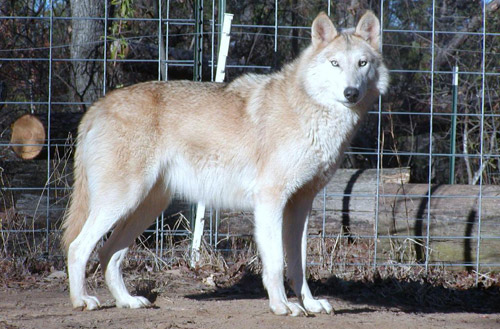
Most have coats that are a combination of grey, black, rust, and
silver grey. They are known to have long thick coats with dense
underfur, and are often
hunted for them. The average life span is approximately 16 years.
The Tundra Wolf Canis lupus albus is one of the largest subspecies of the gray wolf. It was classified as a
subspecies by Robert Kerr in 1792. HABITAT
HABITAT
The Tundra Wolf can be found throughout Northern Europe and Asia from
Northern Finland to the Kamchatka Peninsula, from the far north of
Russia into the Arctic.
They primarily reside in the northern arctic and boreal regions of
Russia roughly between 65 and 71 degrees latitude.Although they were
eliminated from some of
the Arctic islands north of Siberia, they have been recently seen on
Wrangle Island.
The Tundra Wolf can measure up to 7 feet in length from nose to end of
tail. There have been unconfirmed reports of some weighing as much as
220 pounds.
However, on average, Tundra Wolves weigh from 100 to 125 pounds.
Their height can be anywhere from 28 to 38 inches.
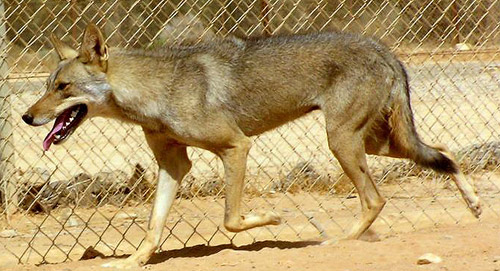
The Arabian wolf is a small, desert adapted wolf. Their ears are proportionally larger in relation to body size when compared to other species, an adaptation needed to disperse body heat. Also, Arabian wolves do not live in large packs, and instead hunt in pairs or in groups of about three to four animals. This subspecies is unusual, as it is not known to howl.[2]. Arabian wolves are unique among grey wolves due to the middle two toes of their paws being fused, a trait originally thought unique to the African Wild Dog.[3]feral dogs. This poses a very serious threat to the survival of this subspecies.It is distinguished from the Iranian Wolf[4] Like other wolves, the Arabian wolf's eyes are yellow, but many are found with brown eyes — a certain indication that a portion of the population is not of pure blood anymore and that their ancestors have interbred with by its paler fur, smaller size and proportionally smaller head.
Arabian wolves will attack and eat any domestic animal up to the size of a goat. As a result, farmers will not hesitate to shoot, poison, or trap them. Arabian wolves also feed on hares, rodents, ungulates, and any carrion they can find.
Arabian wolves will hunt small to medium sized animals such as cape hares, Dorcas Gazelles and ibexes, though they will feed on carrion and livestock when in the vicinity of human settlements.[5]
In Oman, the wolf population has increased significantly since hunting was banned, and there is a strong possibility that they will naturally reestablish themselves in certain places within the region in the relatively near term. In Israel, there are between 100 and 150 Arabian wolves all over the Negev and the Ha'arava.
The wolf was frequently mentioned in the Scriptures as an enemy to flocks (Sirach 13:21; Matthew 7:15), and an emblem of treachery and ferocity, and bloodthirstiness. The tribe of Benjamin, owing to its warlike character, was compared to a wolf.
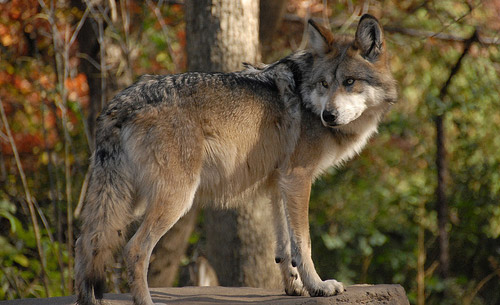
Diet
Mexican wolves mostly eat ungulates
(large hoofed mammals) like white-tailed deer, mule deer and elk.
They are also known to eat smaller mammals like javelinas (wild pigs), rabbits, ground squirrels and mice.
Mexican wolves once ranged from central Mexico to southwestern Texas,
southern New Mexico and southeastern Arizona. Today, the Mexican wolf
has been reintroduced to the Apache National Forest in southeastern
Arizona and may move into the adjacent Gila National Forest in western
New Mexico as the population expands. See a Mexican wolf range map >>
Mexican wolves prefer to live in mountain forests, grasslands and shrublands, and are very social animals. They live in packs, which are complex social structures that include the breeding adult pair (the alpha male and female) and their offspring. A hierarchy of dominant and subordinate animals within the pack help it to work as a unit.
Reproduction
Mating Season: Mid February-mid March.
Gestation: 63 days.
Litter size: 4-7 pups.
Pups are born blind and defenseless. The pack cares for the pups until they mature at about 10 months of age.
 Efforts
to avoid conflicts with livestock gained some momentum last year with
landowners in Arizona and New Mexico joining Defenders of Wildlife in
helping to keep livestock and wolves apart. In 2008, Defenders of
Wildlife helped six landowners implement projects to reduce conflicts
between livestock and wolves, including installing fencing outfitted
with fladry (red streamers attached to fences) and employing additional
range riders to help keep wolves away from livestock. Learn more about Defenders of Wildlife's work to ensure recovery of the lobo >>Humans and habitat destruction pose the greatest threat to Mexican wolves.Defenders of Wildlife has been a leader in wolf conservation since wolves first appeared on the federal endangered species list.
Efforts
to avoid conflicts with livestock gained some momentum last year with
landowners in Arizona and New Mexico joining Defenders of Wildlife in
helping to keep livestock and wolves apart. In 2008, Defenders of
Wildlife helped six landowners implement projects to reduce conflicts
between livestock and wolves, including installing fencing outfitted
with fladry (red streamers attached to fences) and employing additional
range riders to help keep wolves away from livestock. Learn more about Defenders of Wildlife's work to ensure recovery of the lobo >>Humans and habitat destruction pose the greatest threat to Mexican wolves.Defenders of Wildlife has been a leader in wolf conservation since wolves first appeared on the federal endangered species list.
